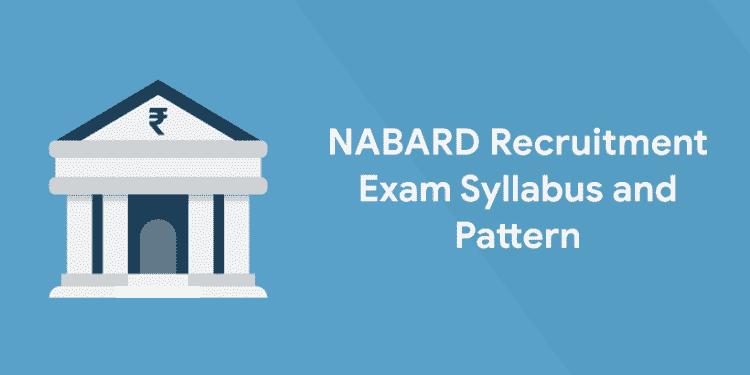Table of Contents
NABARD, functioning under the Government of India, has a great vision for promoting Rural Prosperity. It generally conducts recruitment exams for various posts. Many candidates apply for this lucrative job every year and thus there is a very tough competition too. In this article, we are discussing the NABARD Exam Syllabus and Pattern. So that the aspirants can start the preparation soon.

NABARD Exam Syllabus and Pattern
NABARD Exam Pattern
Usually, the recruitment exams conducted by the NABARD is having three phases:
- Phase I – Preliminary Examination (Online Exam)
- Phase-II – Main Examination (Online and will be a mix of MCQ and descriptive patterns)
- Phase III – Interview
Exam Pattern: Assistant Manager Grade A and B
Phase I – Preliminary Examination
The Preliminary Examination is only qualifying in nature and is meant to serve as a screening test. The exam will be Objective Type with Multiple Choice Questions for both Grade A and B carrying 200 marks.
Duration: 120 Minutes. There is negative marks-1/4th of the assigned marks will be deducted.
- Test of Reasoning – 20 marks
- English Language – 40 marks
- Computer Knowledge –20 marks
- General Awareness – 20 marks
- Quantitative Aptitude – 20 marks
- Economic & Social Issues (with focus on Rural India) – 40 marks
- Agriculture & Rural Development (with focus on Rural India) – 40 marks
Practice daily quizzes to enhance your preparations.
Phase II – Main Examination
- Paper-I – General English: (Descriptive – online through the keyboard). Duration: 1 ½ hrs – 100 Marks
- Paper-II (MCQ): Duration: 1 ½ hrs. – 100 Marks
- For General discipline Paper-II- Economic & Social Issues and Agriculture & Rural Development (with focus on Rural India).
- And for all other disciplines like Animal Husbandry / Dairy Technology, Economics & Agricultural Economics, Environment, Food Processing, Forestry, Finance, Land Development – Soil Science, Plantation, and Horticulture, Paper-II will be related to the respective subjects.
- For Grade B posts, Paper-II (MCQ) Economic and Social Issues and Agriculture and Rural Development (with a focus on Rural India) for General Posts. Duration: 1 ½ hour for 100 Mark
- And Paper-III (MCQ) Analytical Paper on Development Economics, Statistics, Finance & Management, with a duration of 1.5 hours and 100 Mark.
Check the Sample questions for Phase II.
Phase III – Interview
- For candidates qualifying in the Phase-II.
- Marks for Interview: 25 Marks (Grade A).
- Marks for Interview: 40 Marks (Grade B).
Exam Pattern: Development Assistant
Preliminary Examination
- English Language – 40
- Numerical Ability – 30
- Reasoning – 30
- Composite time – 60 minutes
- Maximum Marks – 100
Practice daily mock tests to improve General Awareness.
Main Examination
- Composite time of 90 minutes for Objective Tests and 30 minutes for the Descriptive Test.
- Total Marks – 200
- Reasoning – 30
- Quantitative Aptitude – 30
- General Awareness (with special reference to agriculture, rural development, and banking) -50
- Computer Knowledge 40
- Test of English Language (Descriptive)- Essay, Precis writing, Report / Letter Writing-50
- Development Assistant (Hindi), will be having a test in Professional Knowledge (Hindi) instead of Quantitative Aptitude.
Get the Mock tests for various competitive exams.
NABARD Exam Syllabus
There is no prescribed syllabus for Phase I. The basic topics under each subject can be expected and also, includes the relevant topics matching from the detailed Mains, Phase II syllabus.
Detailed Mains Syllabus
Paper I – English: Essay, Précis writing, Comprehension and Business/Office Correspondence.
Paper-II – Economic & Social Issues and Agriculture & Rural Development
- Economic & Social Issues: Nature of Indian Economy
- Structural and Institutional features
- Economic underdevelopment – Opening up the Indian Economy
- Globalization
- Economic Reforms in India – Privatisation.
- Inflation – Trends in Inflation & their Impact on National Economy and Individual Income
- Poverty Alleviation and Employment Generation in India
- Rural and Urban – Measurement of Poverty
- Poverty Alleviation Programmes of the Government
- Population Trends – Population Growth and Economic Development
- Population Policy in India
Download Entri to avail of free mock test series.
- Agriculture – Characteristics / Status
- Technical and Institutional changes in Indian Agriculture
- Agricultural performance
- Issues in Food Security in India
- Non-Institutional and Institutional Agencies in rural credit. Industry
- Industrial and Labour Policy
- Industrial performance
- Regional Imbalance in India’s Industrial Development
- Public Sector Enterprises
- Rural banking and financial institutions in India – Reforms in Banking/Financial sector
- Globalization of Economy
- Role of International Funding Institutions – IMF & World Bank – WTO
- Regional Economic Co-operation. Social Structure in India
- Multiculturalism – Demographic trends – Urbanisation and Migration
- Gender Issues Joint family system
- Social Infrastructure – Education – Health and Environment
- Education – Status & System of Education
- Socio-Economic Problems associated with Illiteracy – Educational relevance and educational wastage
- Educational Policy for India
Read the latest General Awareness topics to ace your preparations.
- Social Justice: Problems of scheduled castes and scheduled tribes – socio-economic programs for scheduled castes and scheduled tribes and other backward classes
- Positive Discrimination in favor of the underprivileged
- Social Movements
- Indian Political Systems
- Human Development
- Current Economic & Social Issues
- Agriculture & Rural Development
- Agriculture: definition, meaning, and its branches
- Agronomy: definition, meaning, and scope of agronomy
- Classification of field crops
- Factors affecting crop production, Agro Climatic Zones
- Cropping Systems: Definition and types of cropping systems
- Problems of dryland agriculture
- Seed production, seed processing, seed village
- Meteorology: weather parameters, crop-weather advisory
- Precision Farming, System of Crop Intensification, organic farming
Get daily Current Affairs capsules.
Rural Development
- Concept of Rural Area, Structure of the Indian Rural EconomyImportance and role of the rural sector in India- Economic, Social and Demographic.
- Characteristics of the Indian rural economy, causes of Rural Backwardness.
- Rural population in India; Occupational structure, Farmers, Agricultural Labourers, Artisans, Handicrafts, Traders, Forest dwellers/tribes and others in rural India
- Trends of change in rural population and rural workforce; problems and conditions of rural labor
- Issues and challenges in Handlooms
- Panchayati Raj Institutions – Functions and Working.
- MGNREGA, NRLM – Aajeevika, Rural Drinking water Programmes, Swachh Bharat, Rural Housing, PURA, and other rural development programs.
Improve your Prelims preparation, practice more mock tests.
Paper – III
- Development Economics: Measures of development, Economic Development Models, the role of subsidies, the importance of savings and investment.
- Importance of agriculture, Terms of trade in agriculture
- Development issues in India – Post-2015 Agenda.
- Statistics: Basic statistical concepts, Summarizing of data, Frequency distribution, Measures of Central Tendency, Relative dispersion, Elementary Probability, Relative Frequency Approach, sampling, Axiomatic Approach, Analysis of frequency distribution, Correlation, Regression, Sampling Methods, Time Series Analysis.
- Finance: Financial system in India; Regulation of Banks & Financial Institutions
- Banking and Financial Institutions in India
- Financial system- features, characteristics, and issues
- Microfinance, its significance, and importance
- Union Budget
- Project finance- Assessment and Sources for block capital, working capital
- Infrastructure financing- Risk Management in Banking Sector
- Sources of capital, instruments, and methods, salient features
- Development finance- scope and needs of development finance
- Concept of project cycle management
- Private and Social Cost-Benefit
- Significance of development finance
- Financial Inclusion – Use of Technology, Public-Private Partnership
- Management: its nature and scope
- The Management Processes; Planning, Organisation, Staffing, Directing and Controlling
- The Role of a Manager in an Organisation.
- Leadership: The Tasks of a Leader, Leadership Styles
- Leadership Theories- A successful Leader versus an effective Leader.
- Human Resource Development: Concept of HRD; Goals of HRD
- Performance Appraisal – Potential appraisal and development
- Performance Counselling – Career Planning – Training and Development – Rewards – Employee Welfare. Motivation, Morale, and Incentives
- Theories of Motivation; How Managers Motivate; Concept of Morale
- Factors determining morale; Role of Incentives in Building up Morale.
- Communication: Steps in the Communication Process; Communication Channels- Oral versus Written Communication
- Verbal versus Non-verbal Communication, upward, downward and lateral communication
- Barriers to Communication
- Role of Information Technology
- Corporate Governance: Factors affecting Corporate Governance, Mechanisms of Corporate Governance.
So, this is all about the NABARD Exam Syllabus and Pattern for upcoming exams. Start your preparation for this job which is an equally prestigious and tension free job.













